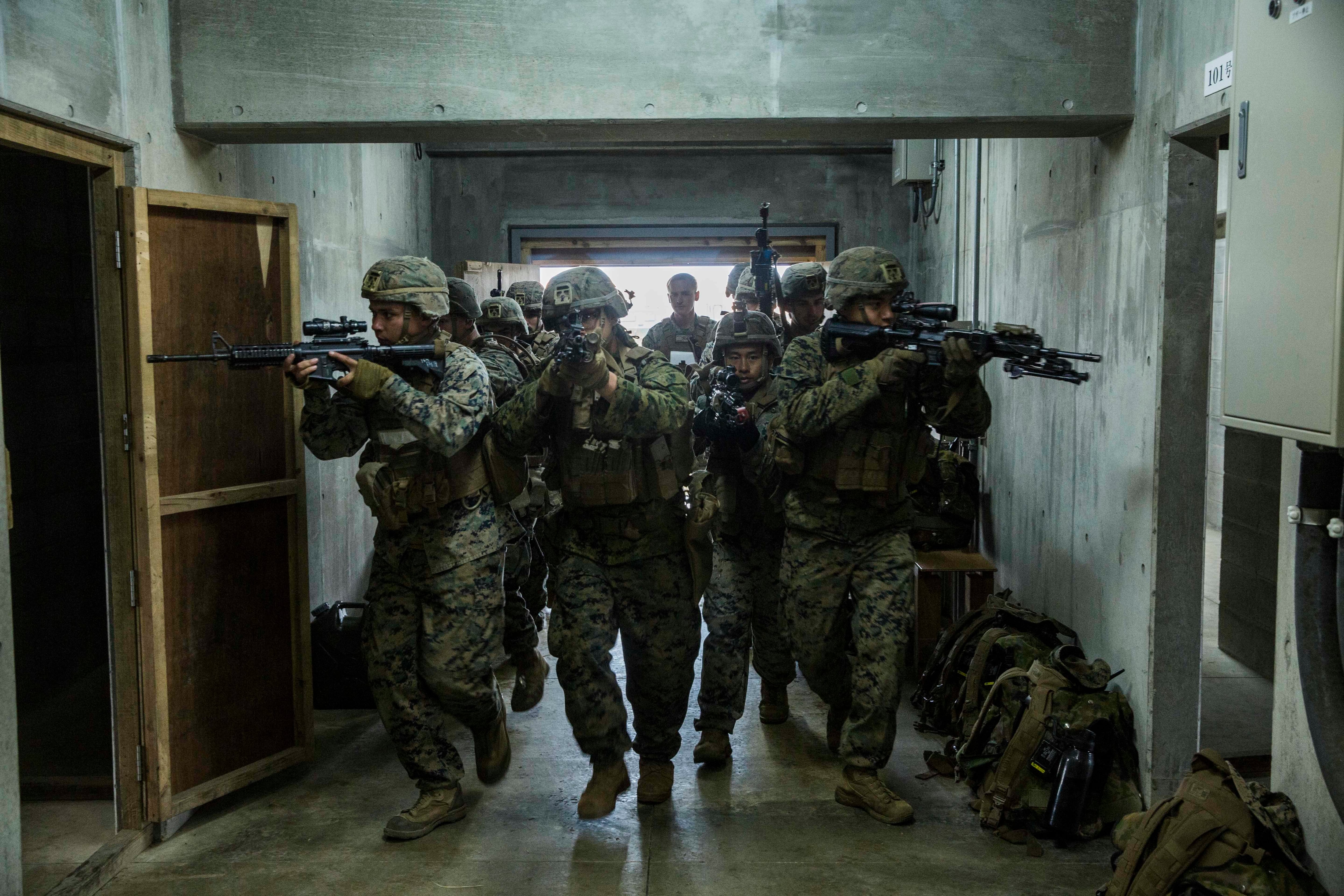After nearly two decades of fighting wars all over the Middle East, the Corps is looking to fight in a new clime and place, using new tactics to take on near-peer enemies.
The Corps’ shift to the Pacific and emphasis on expeditionary advanced base operations comes with a cultural shift and shift in the actual assets and capabilities it demands.
The Corps already has ditched its tanks in efforts to re-invest in other higher priority projects, like long-range anti-ship missiles, as Marine Corps Commandant Gen. David Berger shapes the force for the 2030 battlefield.
The Corps is now taking those changes to the schoolhouses. On Jan. 25, the School of Infantry–West at Camp Pendleton, California, launched the pilot program, a 14-week Infantry Marine Course, or IMC.
In addition to extending the standard SOI course and adding new skills to the curriculum, the course will start training Marines for the new geographic focus and strategy.
RELATED

The “2030 fight”
One of the first IMC courses new Marines will take as a newly made 0311 rifleman will be a class where the Marine will fit into the expeditionary advanced base operations concept and the “2030 fight,” a slide about the upcoming course said.
“The commandant has said we are going to operating in littorals, expeditionary advanced base operations,” Lt. Col. Walker Koury, the Infantry Training Battalion–West commander, told Marine Corps Times.
“Let’s get these Marines in the mindset they might face when they are on the edge of the battlefield … operating independently by themselves,” Koury added.
In addition to the early introduction of the expeditionary advanced base operations concept, the Marine IMC will attempt to give the Marines “increased aquatic confidence,” the slide said.
The course will use the current Marine Corps swimming curriculum, along with a few tips from reconnaissance Marines ― some of the most qualified swimmers in the Corps ― to improve the future infantry Marines’ swimming ability in anticipation of a fight in the littorals.
“We are looking to increase the capabilities of these Marines through a graduated approach,” said Chief Warrant Officer Amatangelo “AJ” Pasciuti, the gunner for Infantry Training Battalion–West.
Koury said a new 0311s graduating from the course will not be close to a recon level swimmer but, “will be a competent enough swimmer, and competent in the water, that whatever amphibious platform the Marine Corps decides to put him on, he can safely get from the water to the shore.”
The schoolhouse will not have a specific level of swimming the Marines are required to reach before passing, but that may change in future iterations of the course and when the final product is fully implemented, said Col. Coby Moran, commander for School of Infantry–West.
Marksmanship techniques
Beyond recon, the creators of the new course took a few tips from the Department of Homeland Security and the Expeditionary Operations Training Group on how to improve the individual Marines’ ability to use their service rifles.
The tips led to a reduced number of hours at the range, but ideally a better use of those hours, Pasciuti said.
“What we’re fundamentally doing is changing how we teach these weapons systems themselves,” Pasciuti said.
Pasciuti said the recent method of teaching marksmanship at the School of Infantry was like telling the students, “the stove is hot.” The current method is allowing the students to touch the stove and learn for themselves it’s hot ― in a safe environment.
The gunner explained that the Marines will use the Marathon targeting system, wheeled robots capable of different programmable behaviors that can recreate real reactions to being shot at.
“Those things are amazing,” Pasciuti said.
Through various iterations of these ranges, along with guided by the combat instructors, the students will slowly learn improved marksmanship skills.
They also will be able to get their hands on a wider variety of weapons, something that will have increased importance as the Corps plans on putting smaller and smaller units in more isolated and dispersed locations.
“Across every single weapon system that we’re teaching they’ll learn the fundamentals, they’ll learn the employment of the weapon system and then they’ll get to experiment with the employment in real life, live fire and force on force situations,” the gunner added.
The concept of fighting a near-peer opponent will be reinforced by multiple unscripted force-on-force exercises that will see 14-man squads of the students, led by a single sergeant instructor meant to guide rather than directly lead, faceoff against their peers.
They will be expected to conduct successful patrols, assaults, ambushes and defenses against their peers in multiple different environments, with each scenario getting more difficult as the course goes on.
The culminating event will see the Marines “deploy” to an expeditionary advanced base for roughly five days where they will work through the mission sets associated with the strategy.
Though the new training will have a heavy focus on the future, the current School of Infantry staff said it will balance the need for the future with the Corps’ need for the present.
“We can’t produce a product that’s chasing a future operating concept or environment that may never play out, they have to be relevant immediately,” Moran said.
“Ultimately the Marine that we produce through the IMC (program of instruction) is fundamentally at the most basic level of better infantry Marines, full stop,” he added.





